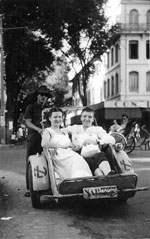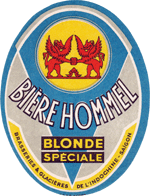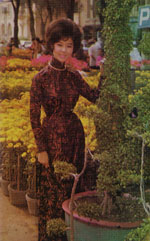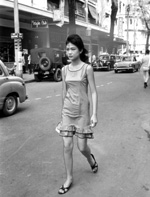

Saigon
Pearl of the Far East
A location in Saigon, with the cathedral bell towers in the background.

Saigon Aerial view and map in 1953
Saigon started off as a small Cambodian port; a fishing village called Prey Kor.
Inhabited by Annamites starting in the 17 century, the site came to be called Saigon, and was surrounded by walls in the 18th century before being conquered by the French in 1859.
Saigon would then be known for years as "The Paris of the Far East": the town has numerous colonial monuments.
The "Saigonese City"
by Christine Chanut
An article which appeared in the monthly magazine, ‚ÄúSud-Est‚ÄĚ (Southeast) in April 1950, published by :
"Le Verseau" publishers
14 Charner Boulevard
Saigon
Notre-Dame Cathedral

Saigon : “She has no more virtue or vices than other cities;
she lives exuberantly‚ÄĚ"
Albert Vivies (avocat lawyer in Saigon)
The crack of dawn:
Slowly the dawn and the suburbs: Tandinh, Gladinh, Phumy, Phuto…, awaken and empty out. By animated roads, always the same, flow streams of humans that are absorbed by the port and the lower part of the city.
Noon :
The streams re-form again in the opposite direction, while the city, weary from having to deal with the comings and goings of mopeds, bicycles, and cars, dozes in the moist heat and the burning silence.
Toward evening:
The streams re-form again, but a feeling of languor takes over the streets, gets into the cafe terraces where men attempt to slake their thirst or to drown their boredom in ice-cold euphoric beverages; and the city changes face: made up with neon, laughing with all its lights, she increases her nighttime calls, promising the humans what every city in the world promises…
Subjected to the rhythm of these pulsations, placed at the confluence of the eddies of the port and the calmness of the ‚Äúplateau‚ÄĚ, city of the hinterland and a big city, city of the East and of the West, Saigon offers contrasts and dissonances, as well as harmonies, which give her the trembling and changing face, appealing, like everything that is characterized by an intense lifestyle.
Catinat Street
In front of the ‚ÄúLa Pagode‚ÄĚ (The Pagoda) Tea Room
In the left photo: At eleven in the morning Catinat Street sees an uninterrupted flow of cars, cyclo-pousses (cycle rickshaws), and pedestrians.
Sur la photo de droite : la rue Catinat deux heures plus tard, à l'heure sacrée de la sieste.
Aerial view of Saigon
In the left photo: ¬ę¬†The city forms a sort of trapeziod delineated by the port, Lagrandi√®re Street (on the left), the Somme Boulevard (on the right), and the market (in the foreground).
In the photo on the right: Charner Boulevard and Catinat Street.
Formerly, none of this existed.
"In 1859, wrote André Baudrit, located at the confluence of the Chinese Arroyo and and the river, was a rickety pagoda in the middle of a group of huts: this was Cho-Soi; then, going back up the river to the mouth of the Avalanche, the swamps spread, bisected by a few miry and nauseating canals (now The Somme and Charner boulevards). Halfway between the Chinese Arroyo and the Avalanche, was a royal bath-house. It was built on a bamboo raft. From there began a red-earth path that connected the river to the plateau: it was the forerunner of Catinat Street around which the future city would be built. Along its route, it squeezed between an old pagoda and a dilapidated cottage".
In 1861, Pallu de la Barri√®re painted a very unflattering picture of the place: ‚ÄúThis potholed street, these sparse houses, this somewhat miserable layout, it‚Äôs Gia-Dinh-Th√†nh, which we call Saigon‚ÄĚ.
Nevertheless, full of faith in the future, the author added: “Perhaps some day a beautiful and populous city will rise upon this place, where we saw an Annamite village…"
Two years later the town had already changed its appearance: "Wide paved roads, bisecting each other at right angles at intervals, had replaced the narrow and curved lanes of the Annamite town: however, the houses were still falling short in many aspects to fill this regular framework", wrote Hailly in 1863.
"It is as of 1865", points out André Baudrit, "that the city of Saigon begins its rising march toward the blossoming for which we know her today, and it is Admiral de la Grandière who is behind this truly prodigious transformation".
In less than fifteen years the city was laid out according to its broad strokes. And, from then on, while following the fluctuations inherent to any human undertaking, she hasn’t stopped growing and prospering.
The port of Saigon
A link created between the port and the ‚Äúplateau‚ÄĚ, the lower town has a double personality.
It blends with the port, to the point where Francis de Croisset wrote:
"Masts stick up between trees or seem to be coming out of a rooftop"; and, "the forest" of the "plateau" is preceded by the large tamarind trees which line Catinat Street, the yaos of Francis Garnier Square, and by the children’s playground which spreads out under the shade of the dark domes of the mango trees".

Perhaps it’s these trees of Catinat Street which confer upon Saigon that provincial-town personality which has struck so many writers: "Between Saigon and the French provinces they create a sentimental link; when I lounge about in their shade, said Pierre Andelle, I have warm feelings for Digne, for Alençon".
"The French provinces? wrote Francis de Croisset during the 1930’s, perhaps that is why Saigon constantly enchants me".
Guy de Portalès described the capital of Indochina :
"Here you are in a small provincial town, Somme Boulevard, Charner boulevard, Catinat Street, the Municipal Theater, City Hall. It is France. The cafes, the streetcars, the tobacconist, the Hotel Continental. Another Cannebière, a wide, straight artery where you can smell the colonial woman, the gigolo, the bureaucrat, the soldier. All that is very middle class, noisy, dusty, barely enlivened by a touch of color. The houses line up, made of cardboard, standardized by some winning architect from the provinces".
However, around the same period, Luc Dartin saw Saigon through different eyes:
"...With the buildings of Saigon, her motion, her wealth, her real role, her half-foreign, half-French brand, one would think less of a large provincial town than of a similar Belgian or Swiss capital, whose customs and ideas are somewhat like ours".
What would Luc Durtain say now? Would Guy de Portalès recognize his little town?n twenty years, the face of Saigon has changed, her specific traits were developed, her own personality was accentuated: she is something quite different from a provincial town… she is a great capital as witnessed by her size and wide avenues, large buildings, her profusion of light and living aromas, her cafes, her shops, her population and her motion; she currently offers a general order and perspective of which her builders may be proud.
City Hall
Charner Boulevard with City Hall in the background.
Saigon has its ‚ÄúGrand Boulevards‚ÄĚ, animated and happy: Bonard Boulevard is heralded by the geometry of a green glare from the healthy lawns and hedges trimmed in the French style in Francis Garnier Square, and Charner Boulevard along which is part of the multi-colored kaleidoscope of the flower market where heady scents linger.
Both lead to vast spaces: the large market place and the clarity of the river; both end at a monument: the recently modernized theater and City Hall… subject of an ancient, but not very dangerous quarrel. On sunny mornings they are gay, bubbly, colored, vibrant, and the fountain that belongs to both, springing from a double basin lined with mosaics adds even more to this luminous gaiety.
The Marketplace
One of the most picturesque places in Saigon is the marketplace where the wealth of Cochin-China, and elsewhere, piles up. All of the neighboring streets pour the most diverse vehicles into it, which are set up all around it, on the immense square, amidst a deafening din from which can be heard the sharp cries of traveling vendors who abound there more than elsewhere.
Each part of the market is specialized, but everywhere people circulate in narrow alleys which are still encumbered by "ganh" carriers.
In the fabrics section, one squeezes between hedges of variegated and resplendent silks and cottons deployed like tapestries or piled up in compact piles: the merchants sit on a sort of stage‚Ķ One thinks of the marvelous ‚ÄúMoroccan souks‚ÄĚ, but here everything is more piled up, more compressed, and one misses that smell of fresh mint that impregnates the merchant streets of Mekn√®s, covered with their trellises of reeds...
The "flea-market", under its thatched roof through which light rays filter, bathes in semi-shadow. The most astonishing things are found side by side. Laymen and collectors poke around, looking for some authentic marvel that has escaped ancient China or royal Hue and sometimes one finds something… or thinks he finds something… but a lengthy apprenticeship is necessary to be able to distinguish among all these new antiques the precious blue, the ancient cloisonné, the polychrome Buddha or quan-ynh of a comforting age ...
Without transition, the sun blinds you in the short space crowded with hungry eaters, that one must cross to reach the basket-weavers, or the potters where so many interesting things pile up, and the fruit market so rich in all these gifts of Indochina whose flavors one can never forget: golden, juicy mangoes; mangosteens with their purple-brown rind; lychees with long bright-red hairs, the tart flesh of which is exquisite. .
The Bonard-Charner Roundabout
The Bonard-Charner Roundabout, with its fountain gushing from a large basin and its flower market is an oasis of freshness and beauty in the middle of the city.
It is in this basin, after the brief twilight, that small nhos frolic with joy in a splash of water sprays and foam that sparkle under the electric light ... while, on the lawns of the square, pedestrians sit on the grass, eager to suck the fresh country air of the night: a whole calm nation is calm there, scattered ... with thoughts ... with which we interact, without knowing them.
The other streets, although not as big, are no less feverish, and each has its own beauty.
In this part that is so alive. Saigon closely combines with its typically Western personalities, the stamp of an Asian city ... a strange harmony that is not the least element of its charm.
Even in the lanes perpendicular to Catinat Street Saigon offers, to he who dreams of the Orient, the flavor of the teeming streets where the Chinese, Vietnamese and Hindu shops still tend to invade most of the sidewalk with their dense and more or less heterogeneous displays.
Everywhere, traffic is of a surprising intensity and diversity…  All the streets are crowded with throngs of bicycles, the terror of motorists, Jeeps who dream only of exploration, French cars, luxury American cars, and countless "cyclos", familiar silhouettes of the city, whose drivers excel at stalking the most generous customer.
Catinat Street
In the photo on the left: The Continental Palace, the meeting place for everyone who is anyone in Saigon.
On the right: ‚ÄúAux Nouveaut√©s Catinat‚ÄĚ, a store founded by Jules Berthet in 1887. An old establishment, a good reputation!
Catinat Street, of which so much has been said and which is fondly remembered by all those who have experienced Indochina.
As the main axis of the city, it is the living illustration of the intimate mixture of East and West, large city and small town, which gives Saigon its special and endearing character not found anywhere else in the cities along the South China Sea.
It has "its trees", its tamarinds that the day’s end slowly turns golden, "its trees" around which so many discussions have sprung, some of them unfortunate, and for fear of mosquitoes, may have forever gone unsettled.
It has its elegant passages reminiscent of those in the capital, its "Southern Cross" which with its dazzling neon cascades, seems like a great cafe in Paris, it has its restaurants, cinemas, shops...
Yet this mixture of Europe and Asia: jewelers, antique dealers, booksellers, silks and trinkets, all this speaks of double standards in the eyes and imagination.
She still has her tea-rooms rustling of gossip, her "Continental" and "Pagoda" where so many things are dealt with: piasters and trivia, serious things and memories, plans and regrets…
It drains the city’s entire contents of strollers and busy people, curious and dilettantes, the talkative and dreamers....
In the mottled gold shadow moves a many-colored crowd, with fresh clothing, and peaceful looks. In this always equal and warm climate, that the profusion of vegetation prevents from being overwhelming, the faces are less tense, more smiling than elsewhere, it seems that everyone is not just busy with themselves ... It seems that people have time to look at the color of the sky, breathe the air of the city, savor the moment ...
Despite the unsettling world that surrounds it, Saigon seems to give each person a chance to relax: soldiers and sailors stroll in front of shop windows or chat on cafe terraces, harassed by the little ‚Äúnhos‚ÄĚ selling roasted peanuts, cigarettes, and watermelon seeds; women, often partially freed from household worries, were more beautiful, elegant and youthful than in many other cities. Sure¬†to find many¬†admirers¬†at the "Pagoda"¬†or¬†"Continental"¬†they have¬†the wisdom to seemingly¬†abandon their¬†worries and to create¬†around them¬†an atmosphere¬†of relaxing futility,¬†beauty, and¬†joie de vivre.¬†Free to move¬†in their¬†light dresses, often¬†tanned¬†by the sun, they are¬†among the finest¬†jewels¬†of the Far¬†East.
More stylish even, the Tamils of the Coromandel Coast move about with their slow pace… the long folds of their saris, the most elegant of dresses, draping them and giving the slimmest of them the appearance of the appearance of Tangara or of a Ming statuette, and giving the more blossoming ones a sovereign appearance… Their ebony hair gathered into a bun at the base of the neck, spiked with white jasmine and daisies, held by tortoise-shell combs set with precious stones, their long shimmering dress hemmed with dazzling gilding, jewelry that enhances their copper complexion… all this adorns them like idols, thousand year-old enigmas of fabulous India… that brightly mottles the cathedral steps on Pigneau-de-Béhaine square on Sunday at the end of mass.
In the photo on the left: Vietnamese women, so graceful in their elegance, rub elbows with our European beauties in a discreet note of exoticism.
In the center photo: women there were more beautiful, elegant and youthful than in many other cities.
In the photo on the right: In the mottled gold shadow moves a many-colored crowd, with fresh clothing, and peaceful looks.
A city of many faces where the light of each hour gives birth to a different smile, a moving city where the eyes of man reflect ever-changing horizons, a city that knows how to live with calm and exuberance. Saigon vibrates under the hot light of the tropics.
"What a country! What an inexhaustible source of lyricism!" said Francis de Crosset and his enthusiasm was in tune with that of American journalist Patrick Smith, who admitted:
"I have traveled in Japan, the Dutch East Indies, India, and Malaysia. I have not suffered; it took a stroll on the streets of Saigon to regain the sweet life, to spend a night in the Continental Hotel to have a square meal. I’ll write to you with joy, because Saigon had been described to me as a city of debauchery…"
Henceforth the capital of the young Vietnamese state, a new destiny opens up for Saigon. May it flourish full of hope according to the ardent wishes of all the French whose love and fervor gave birth to this "Pearl of the Orient" in the vast green delta.

























































 >
>




















































